Four Defense Technology Companies Transforming National Security
The defense industry is undergoing a massive transformation as governments implement advanced technologies into their military operations. As technologies like unmanned drones, robotics, autonomy, and artificial intelligence (AI) continue to develop and demonstrate their effectiveness, we think that they could spark something of a global arms race in both the public and private sectors. Escalating conflicts and instability around the world add urgency to governments’ investments in acquiring these technologies. Global military expenditures reached $2.4 trillion in 2023, growing 6.8% relative to 2022.1
In this scenario, we believe companies specializing in the development of modernized defense systems and the infrastructure required to manage defense operations are poised for exponential growth, including the four companies part of the Global X Defense Tech ETF (SHLD) that we highlight in this blog post.
Key Takeaways
- Palantir: Data infrastructure provider that helps fuse data from disparate sources for analysis and insights
- Raytheon: Major defense contractor facilitating technology-enabled transformation of end-to-end defense platforms
- AeroVironment: Designer and manufacturer of sophisticated drones with a range of autonomous functionality
- Leidos: Defense tech and IT services provider that specializes in custom software and integrations with hardware solutions
Palantir: Delivering Foundational Infrastructure for Data Analytics and AI
Founded in 2003, Palantir initially provided data analysis software to intelligence-focused government agencies such as the National Security Agency (NSA), the Federal Bureau of Investigation (FBI), and the Central Intelligence Agency (CIA).2 Early initiatives for the company included aiding counterterrorism efforts and supporting U.S. military operations in the post-9/11 era.3 At the time, this approach of exclusively servicing government and defense customers was unconventional for a Silicon Valley startup.
Today, these long-held relationships give Palantir a distinct competitive advantage when pursuing contracts for critical end-to-end systems modernization projects. After evolving from bespoke services, the company now primarily provides a foundational data infrastructure platform for government and commercial use cases. One such project involves helping the U.S. Army build a next-generation ground station system in a deal worth over $178 million.4 The Tactical Intelligence Targeting Access Node (TITAN) fuses real-time sensor data, communications data, surveillance data, and other information relevant to the battlefield across various sources. The goal is to provide targeted data and intelligence support to Army ground units.5 Another project is the five-year, $85 million contract that Palantir has with the U.S. Department of Defense (DOD) to help it use machine learning to predict maintenance problems on defense machinery and solve pain points in sourcing parts along the defense supply chain.6
Palantir operates in two main product segments. Palantir’s flagship product, Palantir Gotham, helps counter-terrorism analysts, intelligence agencies, and government departments integrate, manage, and analyze vast and diverse datasets from various sources, encompassing both structured and unstructured data. It facilitates real-time data integration, advanced analytics, and data visualization tools, empowering users to unearth insights, patterns, and relationships within the data.
The second segment, Palantir Foundry, is a modular cloud-hosted software-as-a-service solution that offers data integration, analytics, and other capabilities to government and corporations across diverse industries, including finance, healthcare, and energy. Its applications span data integration and analytics to cybersecurity and risk management. Additionally, Palantir Apollo, the company’s continuous delivery system, helps with the deployment and management of Foundry and Gotham.
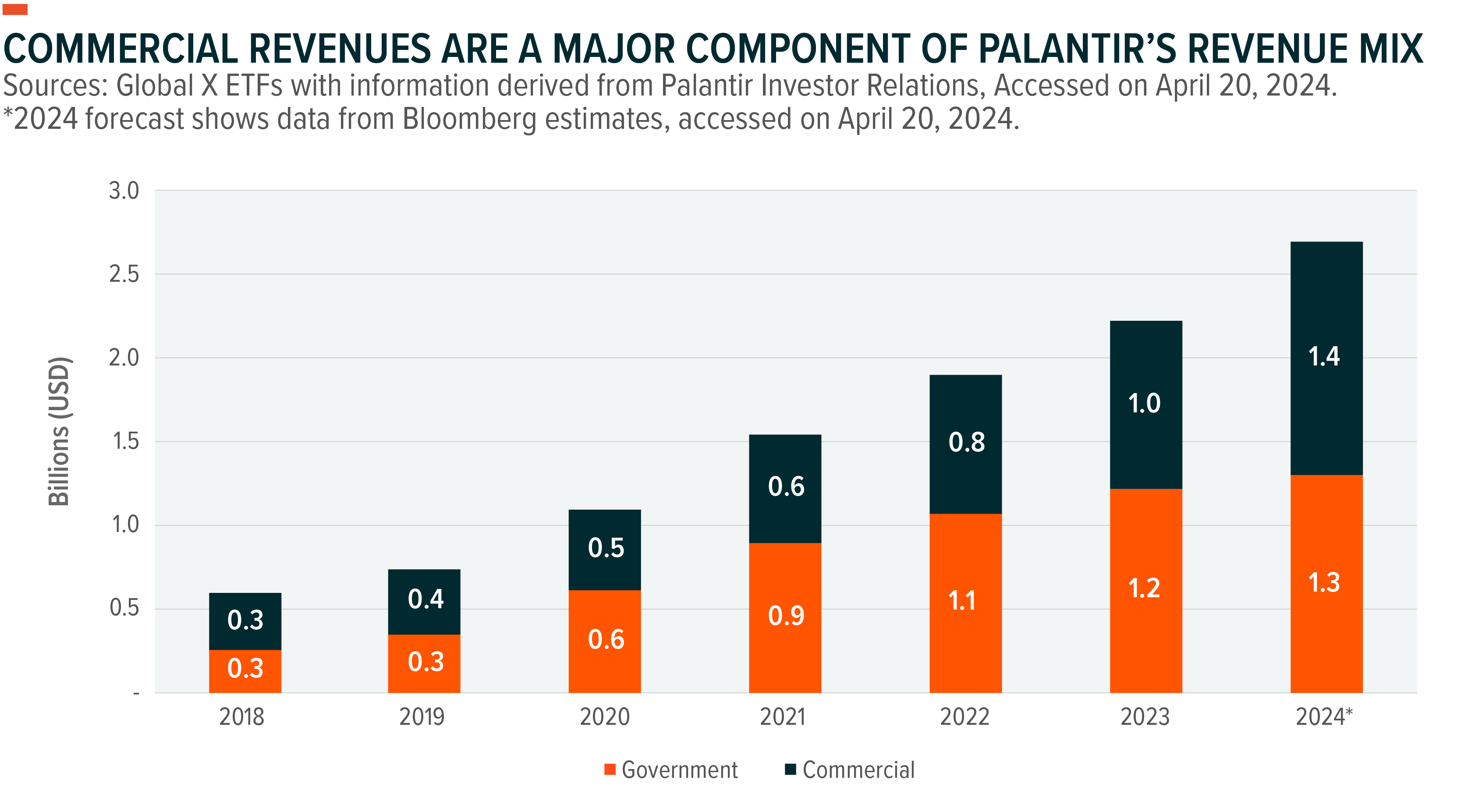
Growing investments by governments and corporations in data infrastructure have helped Palantir grow rapidly. Across all verticals, Palantir delivered $2.23 billion in revenues in 2023, a 17% year-over-year (YoY) jump.7 By segment, government revenue of $1.2 billion grew by 14% YoY, while commercial revenues increased 20% YoY to $1.0 billion, growing much faster than the broader business.8 With gross margins over 82%, adjusted operating margins of 34%, and adjusted free cash flow margins of 33%, Palantir’s profitability at scale stands out.9 For 2024, Palantir expects to top $2.6 billion in revenues and generate close to a billion dollars’ worth of free cash flow.10
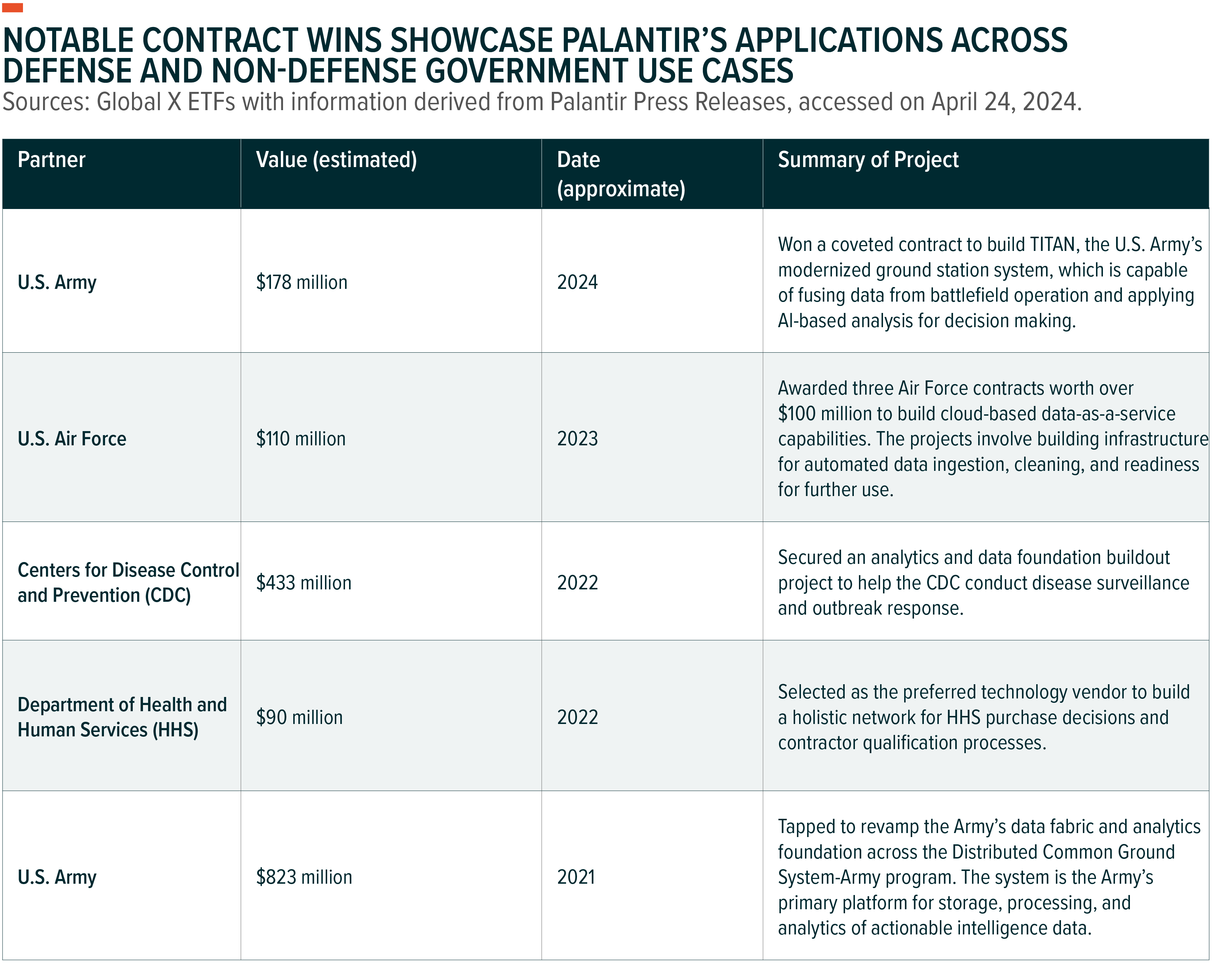
Raytheon: Applying Technology to Legacy Munitions and End-to-End Defense Platforms
Raytheon Technologies, a prominent American defense and aerospace powerhouse, is the second largest defense contractor by revenues.11 The company’s broad portfolio spans commercial and military aviation, space exploration systems, guided munitions, cybersecurity solutions, and advanced electronics, with exposure to products such as integrated air and missile defense radars, precision weapons, electronic warfare systems, and other operational and tactical defense areas. With their extensive involvement across the defense value chain, major defense contractors like Raytheon are poised to benefit from the modernization of end-to-end defense platforms. In 2023, global military expenditures rose 6.8% YoY to $2.44 trillion, a growth trajectory that is forecast to continue for the rest of the decade.12
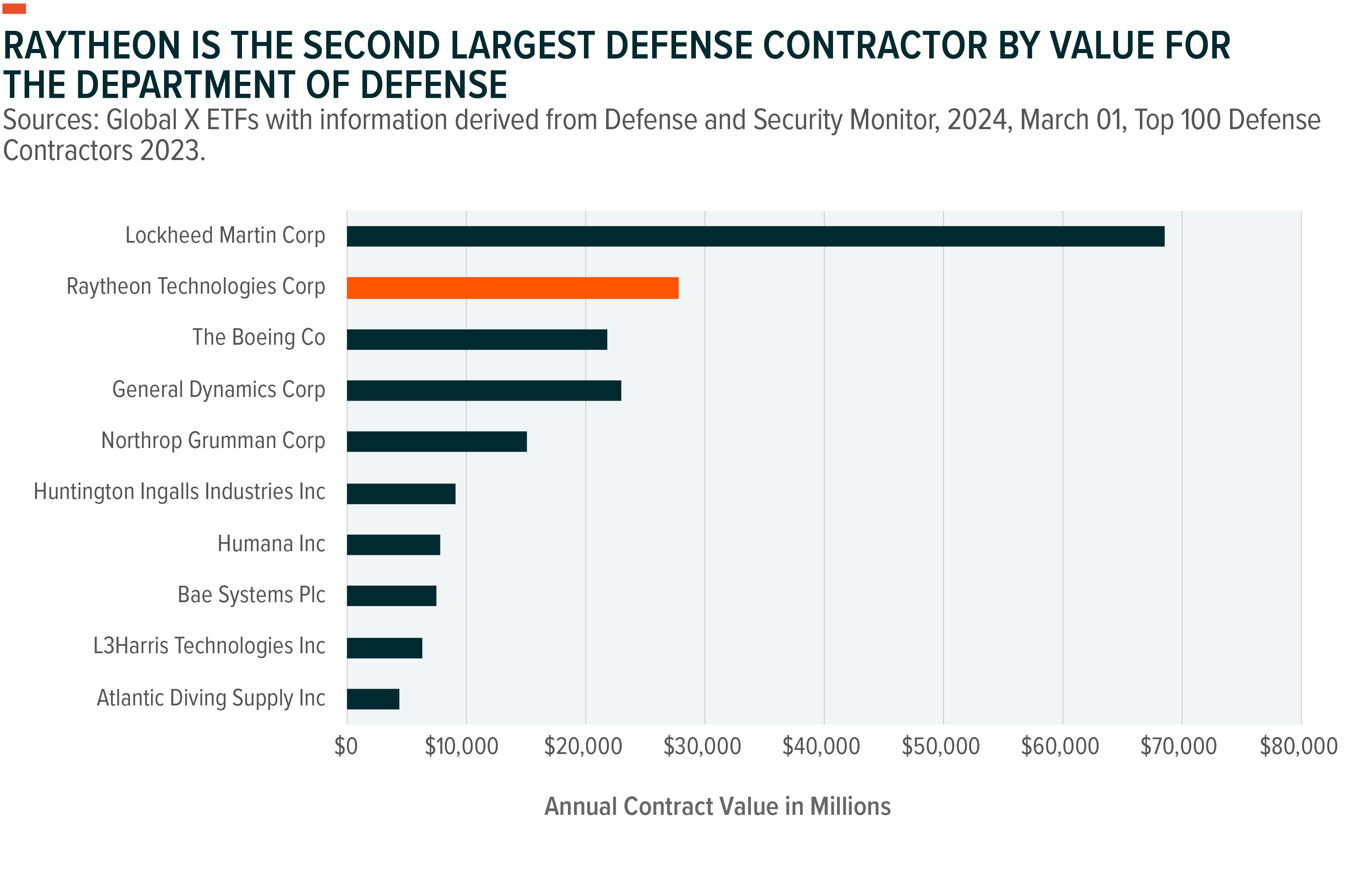
Notable contracts include the $3.2 billion communications systems contract that Raytheon secured with the U.S. Navy in 2022.13 The deal entails Raytheon producing up to 46 cutting-edge SPY-6 Radar Systems for naval vessels including aircraft carriers, ships, and destroyers. Nearly every new Navy surface ship will be equipped with this technology. In 2020, Raytheon secured a $2.3 billion contract from the Missile Defense Agency to supply seven gallium nitride-based AN/TPY-2 radars.14 These radars are integral components of missile defense systems, adept at detecting, classifying, tracking, and intercepting ballistic missiles. Another contract was with the DOD’s Digital Innovation Unit (DIU). Raytheon delivered a Coyote System interceptor drone that is capable of diffusing enemy drones mid-air with the delivery of an explosive.15
Another example of Raytheon’s prowess is its RTX Raiven Platform. This electro-optical sensing system aims to integrate data from various sources, such as LiDARs, combat aircraft, and drones, and create a cohesive and quantifiable network of assets on the battlefield.16 Raiven uses AI, hyperspectral imaging, and LiDAR, or light detection and ranging, to enable operators to see up to 5 times farther and clearer than traditional optical imaging.
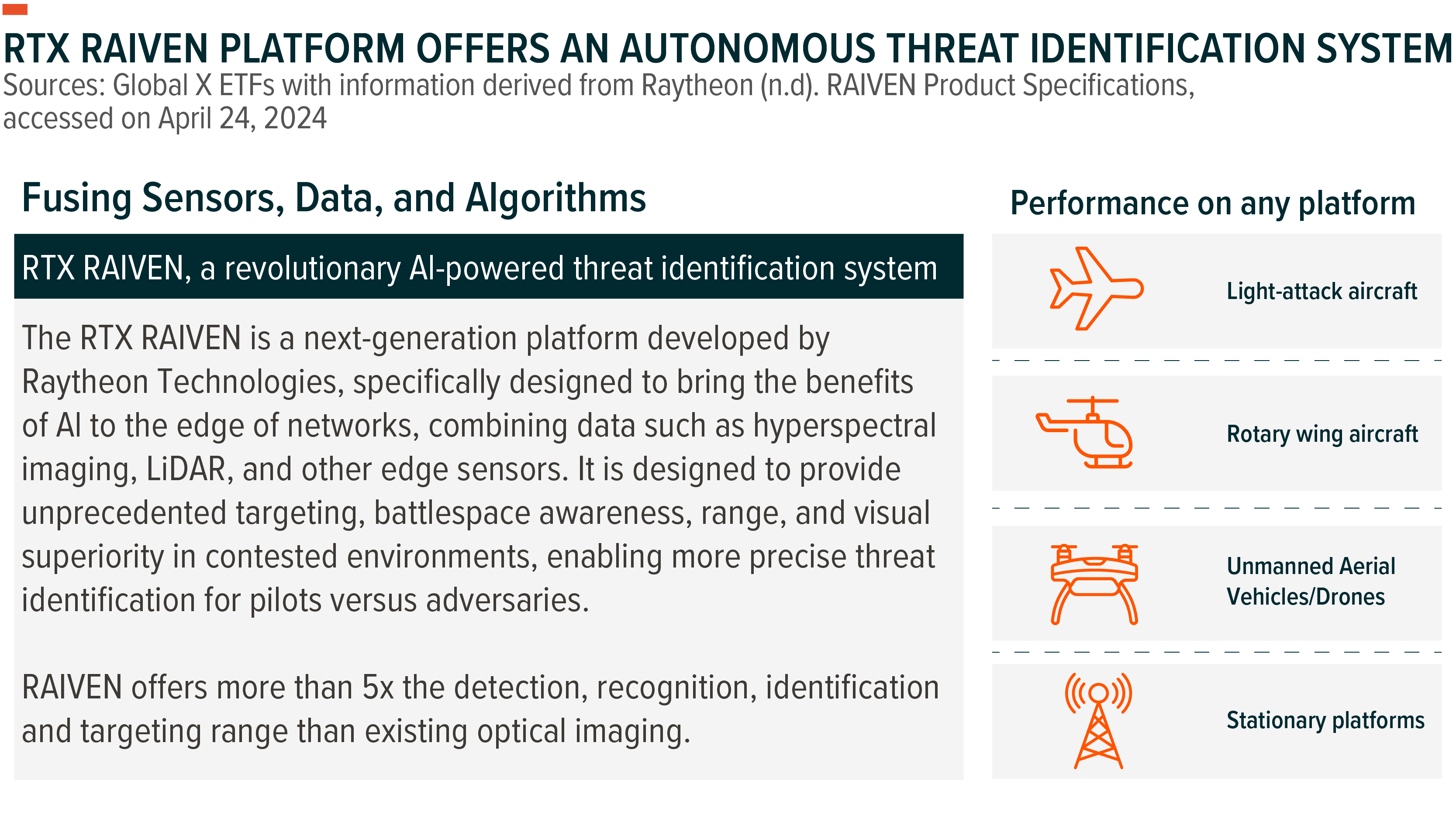
AeroVironment: Revamping Defense Strategies with Autonomous Drones and Ground Vehicles
AeroVironment is a major supplier of autonomous drones for the U.S. and other militaries around the world, as well as large enterprises for non-defense applications. With over 1,000 employees and over $540 million in annualized revenues, AeroVironment is one of the few pure-plays in this segment.17 The company currently benefits from several tailwinds, including the evolution of drone platforms, growing demand for drones in wars, and a planned effort to enable integration of drone deployment, management, and operations across warfare infrastructure.
AeroVironment operates across three major business segments. First, the company provides unmanned drone systems used by ground combat teams to gain situational awareness. For example, the Puma LE Group 2 aircraft falls into the small category of unmanned systems.18 Carried by soldiers in a two-case mission pack, this drone can be launched by hand or bungee. It is designed to work alongside a software layer that shares information across teams in real time.
Second, AeroVironment manufactures unmanned ground vehicles that can be used in situations involving explosives and hard-to-reach areas. For example, AeroVironment’s Telemax EVO comes with a robotic arm and gripper capable of lifting over 175 pounds.19
Third, AeroVironment produces loitering munition systems (LMS), which are missile-drone hybrids that monitor like drones and engage targets by colliding with them. They are increasingly used to support ground teams without constant mobile air support. AeroVironment’s SWITCHBLADE® 600 series features high-precision optics, over 40 minutes of loitering endurance, and an anti-armor warhead for engaging larger, hardened targets at greater distances.20
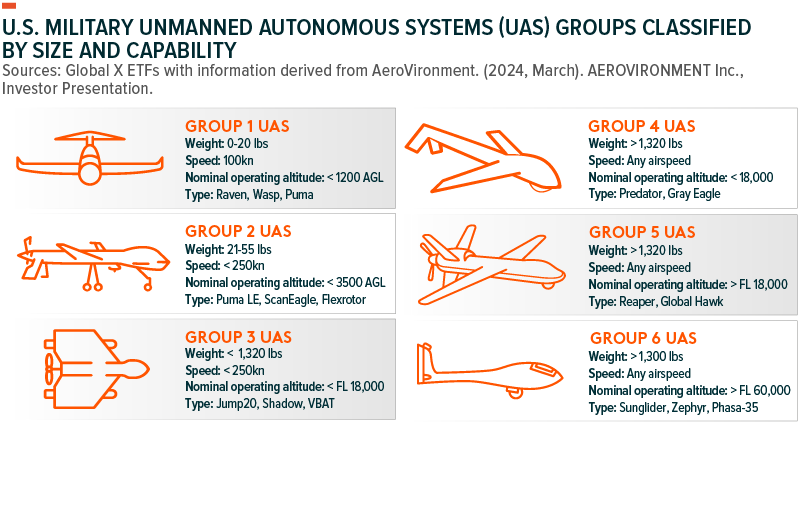
AeroVironment has benefitted greatly from increased defense spending on solutions that provide an edge over legacy ammunition. The company’s solutions have been particularly beneficial for smaller nations, like Ukraine. The trend is expected to continue, with the global military drone market forecast to grow at a roughly 14% annual rate between 2022 and 2030 to become a $35.6 billion market.21
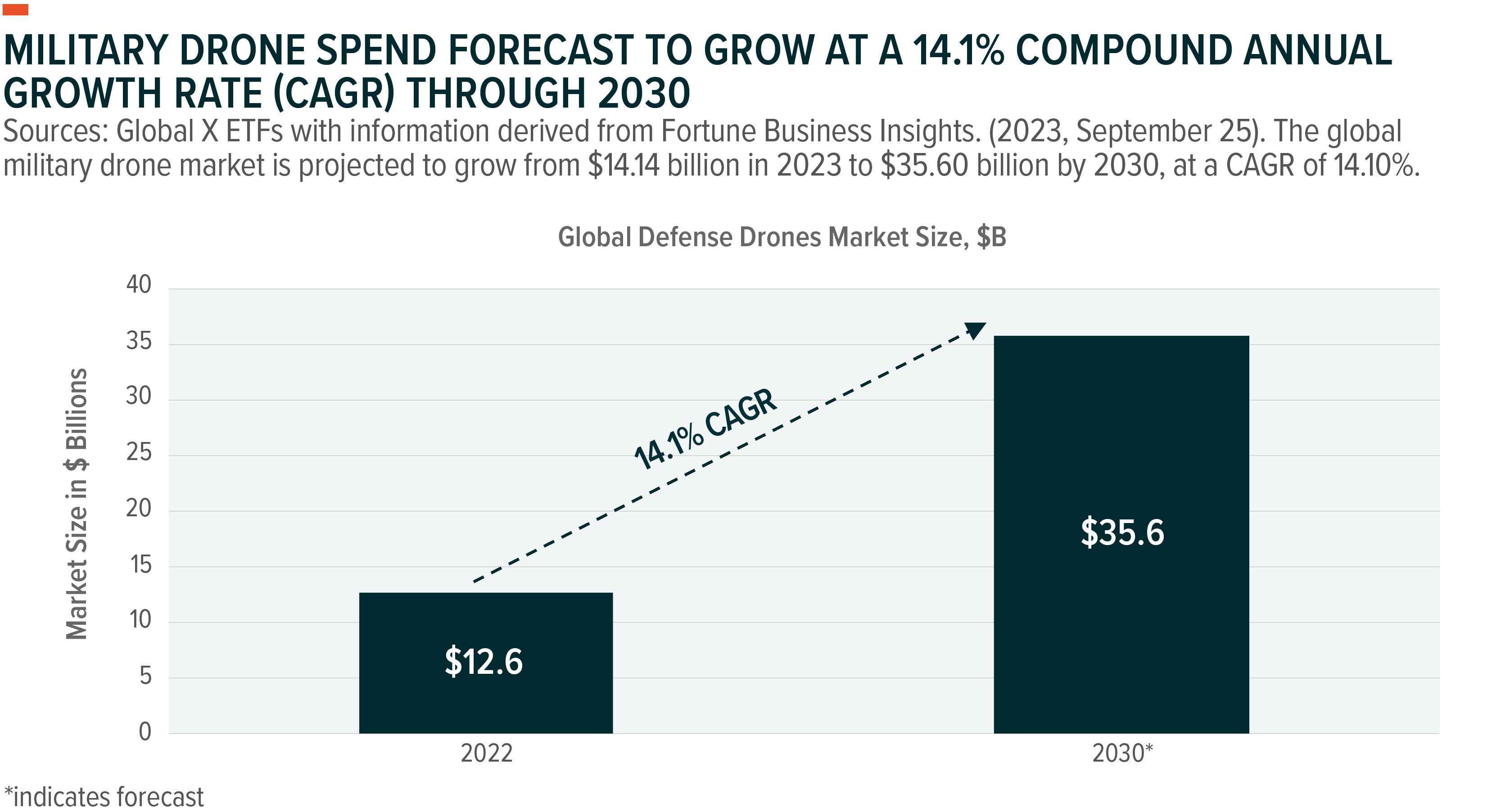
Leidos: Services-First Defense Technology Vendor with Expertise Across Multiple Verticals
Leidos Technologies was founded 50 years ago as Science Applications Incorporated Corporation (SAIC), originally offering scientific, engineering, and technical services to U.S. government agencies. Early projects involved conducting studies on nuclear power and weaponry effects and helping with nuclear disaster cleanups. Over time, the company added capabilities in aviation, energy, and cybersecurity. Notable corporate transformations included the company’s initial public offering (IPO) in 2006, a spin-off in 2013, and a $4.6 billion merger with Lockheed Martin’s Information Systems and Global Solutions business.
Today, Leidos is a $17 billion scientific, engineering, and technical services provider that integrates software with hardware solutions, and delivers IT expertise across bespoke modernization projects. Fiscal 2023 revenues totaled $15.4 billion, up 7.24% from 2022.22 The business is divided into three segments: Defense Solutions (57% of revenues), Civil Solutions (24%), and Healthcare (19%).23

Leidos’ expertise is likely to remain in demand as militaries modernize. Among its more notable projects, Leidos is a key supplier and implementation partner of autonomous technology for maritime applications for the U.S. Navy and the Department of Defense. The company enables unmanned surface vessels (USVs) to perform charted navigation, obstacle avoidance, collision avoidance, and other navigation requirements per international maritime laws.24 In an unmanned capabilities exercise earlier this year, four USVs demonstrated Leidos’ technology by traveling a combined 46,651 nautical miles, navigated primarily by autonomous systems.25 Leidos also has an $84 million contract to provide engineering, logistics, and technical support to help the Navy build undersea warfare systems.26
In another project, Leidos is helping a government agency revamp its contact center communications infrastructure with state-of-the-art communications-as-a-service platforms supplied by Amazon Web Services (AWS) Connect.27 The goal is to connect over 300 agents with softphones and end-to-end technology by using infrastructure built with AWS tools such as OpenSearch, CloudTrail, Lambda, DynamoDB, and Kinesis Firehouse.
On cybersecurity, Leidos supports government agencies and local governments with bespoke solutions to secure end-to-end infrastructure. For example, Leidos is currently supporting the Defense Information Systems Agency (DISA) in its efforts to modernize and secure communications platforms for the DOD, in a project worth over $4.6 billion.28 Leidos is also a major supplier of airport screeners and security systems after acquiring the business from L3Harris in 2020.29 Some of the company’s top products include ClearScan cabin baggage security scanners, ProPassage Automated Tray Return Systems, and the state-of-the-art SafeView people-screening system, which uses millimeter wave technology. SafeView is widely used in U.S. civilian airports.
Conclusion: Technology Is an Indispensable Part of Modern Defense and Security
Defense Technology is one of our highest conviction themes for this decade due to deglobalization, the surge in geopolitical tensions, and the integration of cutting-edge technologies such as AI in military operations. The strategic reconfiguration of supply chains through reshoring and the growing focus on cybersecurity add to our conviction. Performance from Defense Technology companies has been strong over the past year, and we expect companies like the ones we highlight here to continue to benefit from positive market sentiment in anticipation of new contracts and incremental spending.
Related ETFs
SHLD – Global X Defense Tech ETFs
BUG – Global X Cybersecurity ETF
Click the fund name above to view current performance and holdings. Holdings are subject to change. Current and future holdings are subject to risk.
